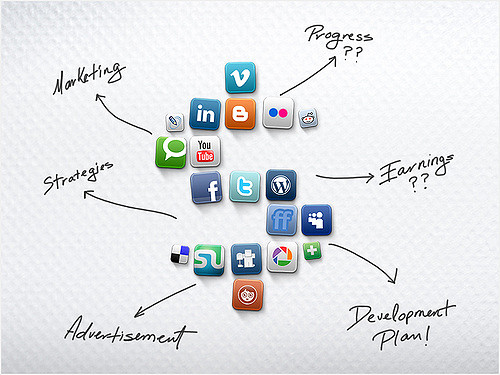
by Fronetics | Mar 15, 2016 | Blog, Content Marketing, Marketing, Strategy

Cultivating a lead is just as important as finding it in the first place
If you have a solid strategic marketing plan in place that is generating a high volume of quality leads, tomorrow’s revenue should be almost assured, right? Not necessarily.
A lead is only worth as much as the effort your company puts into cultivating it. The next vital step is to convert those leads into new sales or clients. In other words, getting quality leads is only half the battle.
Your business grows through a steady stream of quality leads being nurtured and developed. If you have these precious leads in hand, it is vital that you also have a sales team that knows how to turn them into customers. If you don’t, that brilliant strategic marketing plan was a waste of valuable time and money.
There many moving parts to an effective lead-generation campaign, and often there are many steps required to cultivate those leads into sales. Your sales team should:
Conduct consistent, quality follow-up on all leads.
Committing to expedient and professional follow-up provides better conversion of leads into opportunities. This means that when cultivating a qualified lead, you don’t want your sales reps to make one phone call and simply leave a voicemail. You want real conversations to happen. What works best is having someone whose only job is to reach leads in person, overcome objections (identify and present solutions that truly meet your clients’ needs), qualify them (determining whether a lead should move into the sales process), and facilitate any needed connection to your sales teams to complete the sale.
Realize that time is of the essence.
Studies show the faster you contact the lead, the better your chances of conversion into a sale. According to a study by Franklin Covey, contact ratios improve 900% if web leads are called within five minutes of submission. While your sales team may not be able to act upon a lead with that kind of velocity, it is vital that they utilize proactive sales strategies, rather than reactive. Reactive is leaving a message and, if they hear back, responding to it. Proactive is going after the sale with confidence and commitment to engaging the lead in real dialogue.
Target the best window of time to call leads.
This, of course, has many variables and will be relative to your particular business and potential-client demographic. But, one study suggests that Thursday and Friday offer the highest productivity in lead conversion, and the hours between 4 and 6 p.m. often produce optimum results.
Have the ability to listen and offer viable solutions.
Your sales team needs to be well informed about the products, services, and solutions that they are selling. They also need to remember that it’s vital to take the time to discover and understand the potential customer’s needs and wants first, then make the move to match and sell the appropriate solution.
Capturing successful leads is only the first step in generating greater sales revenue. Your sales team must be able to follow up quickly with proven fundamental steps that turn leads into customers.
Related articles:

by Fronetics | Mar 9, 2016 | Blog, Content Marketing, Marketing

The other day a client called to express his frustration with content marketing. Not only was he disappointed with the number of leads that his company had obtained to date, he was also disappointed with the number of sales. He was ready to call it quits and pull the plug on all content marketing efforts.
This client was not the first to call and express frustration, nor will he be the last. Unfortunately, there is a misconception that as soon as a company incorporates a content marketing into their strategy, they will be flooded with leads — leads served on a silver platter and leads all boxed up and tied with a bow. I wish content marketing could do this — it can’t. That being said, walking away from content marketing is a big mistake — content marketing is an effective strategy that companies should employ.
The buying process for B2B buyers has become more complex and longer. The 2015 B2B Buyer’s Survey Report found that 53% of respondents reported their purchase cycle was longer than it was the previous year. The buying process has gotten longer because the majority of buyers (82%) are using more sources to research and evaluate products and services, and they are spending more time in the research phase itself. A full 80% of respondents reported they spend more time on research alone — this is up from 58% in the previous survey.
Social media and vendor-focused content are two key places where buyers turn to conduct research. More than half (53%) of survey respondents reported that social media plays in their research process, and 86% of respondents reported that content such as case studies and product data sheets influence purchase decisions.
The increased focus on research has changed when the buyers engage with a sales rep. Today, the average buyer progresses nearly 60% of the way through the purchase decision-making process before engaging with a sales rep.
Back to my client. I walked my client through these facts, and then we walked through the metrics we track on the monthly basis. Since my client had started using content marketing, traffic to his company’s website had increased significantly, visitors to the website were spending longer on it than they had before, and they were looking at more pages. Additionally the company’s social reach had grown and engagement — with customers, prospects, and others within the industry — had increased considerably. All of these things, I pointed out, were positive. I then reminded my client that the typical sales cycle for his company and industry was 12-18 months — far longer than the few short months that he had been using content marketing.
I spent the next few minutes going over the company’s content marketing strategy. We decided to make a few tweaks, and then discussed both goals and expectations going forward.
It is important for companies to recognize that content marketing should be a part of their strategy — more than ever, B2B buyers are looking for information and are using that information to make buying decisions. Companies need to be using social media. Companies need to be creating and curating quality content. It is equally important, however, for companies to realize that content marketing is not magic. Content marketing doesn’t shorten the buying process; rather it changes it. Moreover, content marketing doesn’t deliver sales — sales people still play a large role in lead nurturing and closing deals.
You may also like:
This was originally published on Electronics Purchasing Strategies.

by Fronetics | Mar 7, 2016 | Blog, Content Marketing, Marketing, Social Media

Your content stinks. Here’s why.
Twenty-seven million pieces of content are shared every day — and most of it is crap. To attract readers to your content, you must stand out, and I mean really stand out, among the masses. That’s no easy feat.
You may be spending an enormous amount of time and money as part of a content marketing effort, but, if no one is reading what you’re producing, you’re definitely not achieving your ROI. Consider the following points, and ask yourself if any could be negatively impacting your readership.
Here are the top 10 reasons no one is reading your content.
10. You don’t have a strategy.
Only 11% of companies without a documented content marketing strategy find their efforts to be successful, compared to 60% of companies with a strategy in place. And that number rises to 86% when the company designates someone to lead the strategy. Having a clear vision for your content and a plan for executing that vision is crucial to earning an audience.
9. Your content isn’t search-engine optimized.
Seventy-seven percent of today’s buyers use Google to research information about products. Search engine optimization (SEO) means writing copy for your digital assets so they will be prioritized by Google in web queries related to your business or products. Three of four people will click on the top five search results. So the further you move from those top five results, the less likely someone is to find, much less read, your content. If your content isn’t SEO-friendly, readers may not even have the chance to see what you’re writing because it is so far down in their search results.
8. You are using the wrong channels.
If a tree falls in the woods and nobody is around to hear it, did the tree fall after all? Stop publishing in the empty woods. Who is the target audience for your content, and where are they active? Evaluate your audience (or lack thereof) in each of the channels where you publish, and see if something is amiss. This will vary greatly by business. You can access personalized information on your followers’ social media habits through analytic programs like Google Analytics and sites like Tweriod.
Also to consider: on lightning-fast platforms like Twitter, a miscalculation of timing could be to blame. (See The Best Time to Post on Social Media.)
7. You’re not publishing often enough.
Inconsistent content is one of the primary reasons readers become disengaged with a particular publisher. Even publishing one more blog post a week can significantly boost your readership. Try a little experiment for a few months by playing with the number of times per week you publish — say, three times per week one month, four times the next, and five the next. You’ll find the sweet spot where you get the most engagement but can also handle the production schedule.
The next reasons have to do with the substance of the content itself.
6. You’re publishing a sales pitch instead of content.
Imagine you’re looking to buy a car. Researching different options online, Site A, run by Dealership A, offers expert opinions about various makes and models, while Site B talks about how Dealership B offers top-notch customer service and a no-nonsense negotiation policy. You’d probably never come across Site B in the first place because the content is irrelevant (and trite… and annoying), whereas Site A has exactly what you’re looking for.
Content marketing is your opportunity to provide valuable, expert information to people who are seeking it out. Associating your brand with that sort of expertise attracts customers — not to mention, helps them find you via organic search in the first place. No one wants to read your sales pitch over and over again, and they won’t.
5. You are not telling the truth.
I am talking about two different definitions of truth here.
For one, are you being honest? Today’s consumers can smell b.s. from a mile away, largely because the Internet forgets nothing and forgives nothing. The prevalence of user-review sites and platforms like social media means customers will always have an outlet to share their experiences, both good and bad. If your business does not provide what you promise, people will be upset and take to these forums to complain about it. Trust and transparency are two key assets in earning (and keeping) readership.
Secondly, are you being true to who you are as a business? A recent Harvard Business Review article defines successful marketers as mission-focused, not consumer-focused. Don’t produce content based on what you think your customers want to hear. The beauty of content marketing is that when you put your business mission out into the universe through content, people who are seeking that information find you. In other words, build it, and they will come.
4. You’re not offering anything of value.
DigitalTonto says, “The first step towards engagement is creating value beyond the basic transaction of payment for a product or service.” This is the essence of content marketing: a related offer of value in the form of expertise, entertainment, etc. For example, L’Oreal Paris provides free makeup tutorials on its YouTube channel, Destination Beauty, and, Apple offers free classes, product demonstrations, and tech support from the Genius Bar for product users.
The question to ask is, what is your value to your customers? Can you offer expert advice on a particular topic through a blog? Is there something about your products or your people that would make for entertaining or informative videos? Do you have access to top-of-their-field specialists that could lead a webinar series? Find whatever it is that is unique to your company, and leverage that in your content marketing to attract readers.
Because there is so much content out there, today’s consumers can afford to be partial to publishers who provide information in a way that is pleasing to them. They also have shorter attention spans than goldfish. That means things like format, length, accessibility, and voice can majorly impact whether people read your content or not. Also, be mindful that different platforms should offer different experiences based on reader expectations (e.g., Instagram isn’t the place for lots of text).
2. You’re not heeding performance analytics.
The one certain constant in marketing is that things will always change. What works for you one year will certainly be irrelevant the next. Content marketing won’t allow you to rest on your laurels, either. You should stay on top of your analytics to monitor what kind of content is successful in the present moment, and you should tweak how you’re doing things as people, technology, and events change. Keep testing new ideas to see how they are received, and get rid of old standbys that no longer pull their weight.
1. Your content is bad.
While this seems obvious, it’s worth repeating. If the quality of your content is bad, no one will read it, regardless of what value it offers. The same goes for if you find yourself saying, “it works,” or “it’s fine!” If there are 27 million options, who would choose “fine?”
Do an honest evaluation of your content, or have a neutral outside party do so for you. Is it original, substantial, and well-written? Make sure that your content is edited, and that it is free from grammatical errors, spelling mistakes, and awkward phrasing. And remember that you get what you pay for. Professional writers can be expensive, but there’s a reason for that — theirs is a specialized craft, and very few people can do it well. If you want people to read your content, you should make sure that it’s worth reading.
Related articles:

by Fronetics | Mar 3, 2016 | Blog, Content Marketing, Marketing, Social Media, Strategy

Source: Rosaura Ochoa | Flickr
Here’s how marketers can launch a B2B social media program that grows business.
A recent Harvard Business Review article discloses that a number of B2B CEOs still believe social media isn’t right for them, that it’s a tool for the B2C segment. In reality, many B2B marketers successfully leverage social media to engage potential customers, gather market intelligence, build brand awareness and reputation, discover and intercept customer problems, and influence purchasing decisions before sales calls are ever made.
In short, if you are not in the B2B social media game, you are missing out on enormous business opportunities.
Getting started with social media can seem like an intimidating task, especially if your C-suite is skeptical of the benefits. Here are six steps to launching a B2B social media program that will grow your business to its full potential.
1) Speak in the right terms.
Convincing management that you want your team to spend more time on social media to gain “followers” or get “shares” might be a hard sell. To win support, focus your argument around the factors that are most important to them. Lead generation, lead nurturing, conversions, sales, ROI, profits: this should be the vocabulary with which you approach this conversation.
2) Create a strategy — and put someone in charge.
Only 11% of companies without a documented content marketing strategy find their efforts to be successful, compared to 60% of companies with a strategy in place. And that number rises to 86% when the company designates someone to lead the strategy. Working with an experienced marketing consulting firm, like Fronetics, you can develop an inbound marketing strategy that aligns with your business objectives. And whether someone on your team heads up execution or you outsource that responsibility, the leader should continually monitor analytics and tweak the strategy accordingly. Which brings us to…
3) Determine which analytics to track.
In the B2B world, it’s not about shares, likes, or impressions, though those numbers speak to your brand exposure. (Read more about so-called “vanity metrics” here.) Leads generated, conversion rates, sales, and ROI are going to be the things you’ll want to track. If you have a good, flexible strategy in place, these metrics will help you adjust your efforts to ensure you’re achieving your business objectives.
See: The Six Marketing Metrics Your Boss Actually Cares About.
4) Develop quality content.
Twenty-seven million pieces of content are shared every day — and a large portion of it is crap. A social media presence could be pretty pointless unless you’re using it to push content that is original, high quality, and representative of your brand. One of the biggest mistakes B2B companies make is using social channels to push a sales pitch. You’ll quickly lose your audience, who is turned off by a strong sales pitch. Social media is about engaging your audience, building brand awareness, and offering valuable information.
See: Three Elements of Good Content.
5) Decide which channels are right for your business.
Who are you trying to reach, and what are you trying to tell them? These are good questions to ask when trying to determine which platforms will comprise your social media program. There’s a wealth of information out there about which channels are used by whom and when. You’ll also want to choose channels that you’ll be able to maintain regularly and which play to your strengths. As an obvious example, if you don’t have the capability to make videos, YouTube probably isn’t for you. Remember, you’ll likely want to work through several different channels to reach a maximum number of potential customers.
See: Which Social Media Channels Should Your B2B Business Use?
6) Follow your competitors.
Following your competitors is a great way to stay up to date on what they’re doing, especially if you don’t have a ton of time or money for competitive research. And when I say “follow,” I don’t mean “copy or imitate.” I mean subscribe to their blogs, engage with them on social media, and like and share their content that you find meaningful for your audience. This way, you become part of the industry conversation happening online, and you know exactly what your potential customers are seeing from (and how they’re reacting to) your competitors.
See: The Role of Social Media in Supply Chain Intelligence.
Related articles:

by Fronetics | Mar 1, 2016 | Blog, Content Marketing, Marketing, Strategy
 A new digital marketing program helped one firm reinvent itself after traditional methods proved ineffective.
A new digital marketing program helped one firm reinvent itself after traditional methods proved ineffective.
A prominent marketing firm was experiencing an all-too-familiar predicament: They had a great product that, for some reason, was not selling. They had been following their traditional marketing regimen; however, something about the purchasing landscape seemed to have shifted, and in a way that rendered their methods ineffective.
Then, a new content marketing program changed everything in just a few months. For the better.
The firm’s business was real estate marketing, and their great product, a community of new homes in a highly desirable location. Real estate, like so many other sectors, has experienced a major shift in buyer behavior in just the last two decades, with the majority of research being conducted online. The firm realized that a digital marketing strategy, unlike traditional print ads, could better reach a wider audience of potential homebuyers.
In less than 90 days after implementing the new content marketing program, sales increased by nearly 40%. Within the year, social reach grew by 325%, web traffic by 250%, and sales by 300%.
Download this case study to learn how the firm achieved such remarkable results.

Related articles:

by Fronetics | Feb 25, 2016 | Blog, Content Marketing, Data/Analytics, Marketing, Strategy
https://www.flickr.com/photos/132604339@N03/22920388895/in/photostream/
The most efficient lead-generation strategy includes a way to capture potential customers’ information.
An effective lead-generation campaign requires several different strategic layers.
Firstly, you must entice potential customers with an exclusive, high-value offer — like ebooks, whitepapers, free consultations, product demonstrations, or discounts. A clear, highly visible call to action (CTA) or two can help ensure they know how to attain it and can encourage them to choose it over your competitors’ offers.
But you’re not done there. Unless you are capturing those quality leads effectively, you could be dropping the ball and missing out on potential customers.
Here are some tips for successfully capturing leads.
You absolutely need to have a landing page for your offer. Your CTA should not take the potential customer to your website’s homepage or anywhere else, but rather to a landing page, which provides your offer and captures the lead information.
Landing pages are one of the most important elements of lead generation and are effective for 94% of B2B and B2C companies, according to research done by MarketingSherpa. A great landing page:
- Describes the offer
- Does not include links to other things on your website that will distract the lead and perhaps send them elsewhere before you can obtain their information
- Is simple and not cluttered with information but emphasizes the benefits of your offer
- Has ways to share the offer on social media
- Has a form to capture the lead information
Capturing leads: It’s all in your form
The last point suggests the next step in your strategy: A good form is how you will successfully capture those leads. It is where your potential customers will provide their contact information in exchange for the special offer you have enticed them with.
So, what makes for a good form?
- Keep it short. The fewer fields you have in a form, the more likely you will receive conversions.
- Avoid using the word “submit” on your form. Nobody wants to submit their information, so use a phrase that demonstrates that they are getting something they want by supplying their information — something simple like “Get it free,” or “Download now.”
- Add a privacy message (or link to your privacy policy) that indicates their email or contact information will not be shared or sold.
Want more leads? Use multiple channels
To generate and capture the most leads possible, completing these steps in just one of your marketing platforms is not enough. Marketers should utilize multiple channels in order to maximize their lead-generation efforts.
The objective is to make it easy for buyers to research, evaluate, and purchase products in any way that is most appropriate for them. Some leads may find you through your blog, some through social media, and some through organic search (which is why all of your content should be SEO-friendly). Thus, you should make sure you are promoting your special offers, effectively placing CTAs, and properly using landing pages and forms in every facet of your digital presence.
Such an efficient, multi-layer lead-generation strategy can reduce your cost per lead while delivering higher quality prospects to your sales team.
Want to learn more? Download for a complete list of innovative tips and proven strategies to improve your lead-generation and -nurturing strategy.
Download guide
Related posts:









